Image processing method and image processing device
a processing method and image technology, applied in the field of image processing methods and image processing devices, can solve the problems of image becoming quite unnatural and one part of the image may not match, and achieve the effect of reducing the processing load
- Summary
- Abstract
- Description
- Claims
- Application Information
AI Technical Summary
Benefits of technology
Problems solved by technology
Method used
Image
Examples
first embodiment
of Image Processing Method
[0087]FIG. 3 is a processing flow chart of a first embodiment of the image processing of the present invention, FIG. 4 is a flow chart depicting details of the similarity evaluation processing in FIG. 3, FIG. 5 is a graph depicting the level difference and edge intensity in FIG. 4, FIG. 6 is a diagram depicting the calculation of the edge intensity in FIG. 4, and FIG. 7 is a table showing the composing method in FIG. 3.
[0088]The image processing of the present embodiment will now be described with reference to FIG. 3.
[0089](S10) Images are shot by a digital camera. In this case, when a shutter is pressed once, the digital camera performs a plurality of short time exposure shooting, and acquires a plurality of consecutive images A and B.
[0090](S12) A processing unit 20 corrects the position shift of two images. Here the above mentioned KLT transform is used. According to the KLT transform, the characteristic points of two images are extracted and tracked to ...
second embodiment
of Image Processing Method
[0123]FIG. 14 is a processing flow chart of a second embodiment of the image processing of the present invention, and FIG. 15 is a diagram depicting the image processing method of FIG. 14.
[0124]The image processing of the present embodiment will now be described with reference to FIG. 14.
[0125](S60) Images are shot by a digital camera. In this case, when a shutter is pressed once, the digital camera performs a plurality of short time exposure shooting, and acquires a plurality of consecutive images A and B.
[0126](S62) A processing unit 20 corrects the position shift of two images. Here the above mentioned KLT transform is used. According to a KLT transform, the characteristic points of two images are extracted and tracked to detect a position shift, and the position shift is corrected. The position shift correction method, however, is not limited to this method.
[0127](S64) Then the processing unit 20 evaluates a similarity between images A′ and B′ for which...
third embodiment
of Image Processing Method
[0145]FIG. 20 is a processing flow chart of the third embodiment of the image processing method according to the present invention, FIG. 21 shows a table of increment values thereof, and FIG. 22 to FIG. 25 are diagrams depicting the operation thereof in FIG. 20. FIG. 20 is a processing flow chart of a variant form of the similarity evaluation step in FIG. 14 and FIG. 16.
[0146](S648) First a processing unit 20 initializes a high similarity counter for counting a number of pixels of which similarity is high, and a low similarity counter for counting a number of pixels of which similarity is low to “0”.
[0147](S650) The processing unit 20 calculates a level difference Δa of each pixel in a corresponding position of images 1 and 2 (images A and B). In the case of an RGB color image, for example, if the color image 1 is R1, G1 and B1, the color image 2 is R2, G2 and B2, and a pixel position is x, y, and the level difference Δa is calculated by the above mentioned...
PUM
 Login to View More
Login to View More Abstract
Description
Claims
Application Information
 Login to View More
Login to View More - R&D
- Intellectual Property
- Life Sciences
- Materials
- Tech Scout
- Unparalleled Data Quality
- Higher Quality Content
- 60% Fewer Hallucinations
Browse by: Latest US Patents, China's latest patents, Technical Efficacy Thesaurus, Application Domain, Technology Topic, Popular Technical Reports.
© 2025 PatSnap. All rights reserved.Legal|Privacy policy|Modern Slavery Act Transparency Statement|Sitemap|About US| Contact US: help@patsnap.com



